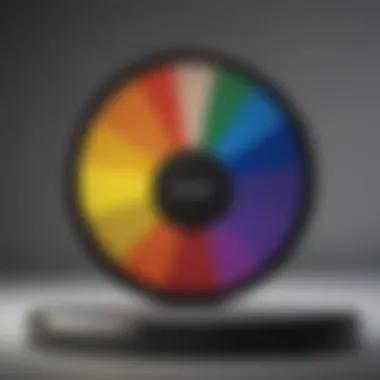Mastering Color Management in Printing Techniques


Intro
Color management plays a crucial role in the printing industry. It ensures that colors are reproduced accurately across different devices, maintaining consistency and fidelity. As the demand for quality printing grows, understanding color management becomes essential for professionals in the field. This comprehensive guide aims to provide insights into the principles, practices, and technologies involved in color management for printing.
Research Context
Background and Rationale
The printing process hinges on various factors, including the choice of inks, substrates, and the capabilities of the printing equipment. Variations in these elements can lead to discrepancies in color output. Thus, robust color management systems become necessary. An effective color management strategy mitigates these discrepancies, enabling printers to deliver high-quality results that meet client expectations.
Literature Review
Extensive research has been conducted on color theory and its application in printing. Studies highlight the importance of understanding color spaces such as RGB and CMYK, as well as the impact of different light sources on color perception. Additionally, academic papers have explored the advancements in color measurement tools and their role in maintaining color accuracy. Review articles have summarized best practices in the industry, and these findings provide a foundation for the methodologies discussed in this article.
Methodology
Research Design
This article employs a qualitative approach, drawing from existing literature, case studies, and industry reports. By synthesizing various sources, we present a cohesive overview of color management practices in printing. The objective is to create a resource that is both informative and practical for professionals navigating the complexities of this field.
Data Collection Methods
Data was collected from reputable sources, including scholarly journals and industry publications. Interviews with experienced color management specialists were conducted to gain practical insights. Furthermore, analysis of case studies from leading printing companies offered real-world examples of successful color management strategies.
"Effective color management is not an option but a necessity in modern printing environments."
Through this exploration, readers will gain a deeper understanding of color management's critical role in the printing sector, equipping them with knowledge to enhance their practices.
Prolusion to Color Management
Color management plays a crucial role in the printing industry, where accurate color reproduction is essential. The necessity of effective color management increases with the diverse range of printing technologies, materials, and color applications. Understanding color management helps professionals ensure that their output meets the expected standards, whether for commercial prints or artistic endeavors.
A coherent color management strategy allows for better consistency across different devices and mediums. This leads to a reduction in errors and issues that can arise during the printing process. By employing color management techniques, companies can save on time and resources while enhancing quality.
Understanding Color Management
Color management involves several techniques and tools that help control the way colors are represented across various devices like monitors, printers, and scanners. The objective is to maintain the integrity of color from the original concept to the final product. Professionals in the field must grasp the different components that contribute to successful color management.
- Color Spaces: Color spaces define the range of colors that can be captured or displayed. Understanding different color spaces, such as RGB and CMYK, is fundamental for anyone involved in printing.
- Color Profiles: These are vital for ensuring that colors translate accurately across devices. ICC profiles, which follow a standard, serve as a bridge between different devices, allowing for uniform output.
- Calibration Techniques: Regularly calibrating devices helps maintain consistent color output by aligning device performance with predefined standards. Regular calibration should not be overlooked in any color management workflow.
- Measurement Tools: Utilizing spectrophotometers and colorimeters allows for precise color measurement. This enables printers and designers to make informed adjustments based on accurate data.
Effective color management contributes significantly to the quality and reliability of printed materials. Understanding it is not optional but a requirement for those who strive for excellence in color accuracy.
Fundamentals of Color Theory
Understanding the fundamentals of color theory is crucial for anyone involved in the printing industry. It provides a solid basis for how colors interact and can significantly affect color reproduction. This knowledge is not just theoretical; it has practical implications during all phases of production, from design to finished output. If the basics of color mixing, harmony, and contrast are not mastered, the risks of poor color representation increase, which can lead to dissatisfaction among clients and stakeholders.
The principles derived from color theory help in predicting outcomes when certain colors are combined or layered. They offer insights into how colors can be used effectively in various media and under different lighting conditions. Familiarity with these principles ensures that designers and printers can achieve more precise and consistent results, ultimately enhancing the quality of the finished product.
Furthermore, understanding color theory aids in the selection and use of appropriate color spaces. As different processes may employ different color models, comprehending how these models relate to one another is essential for maintaining color fidelity.
The Color Wheel and Color Models
The color wheel serves as a fundamental tool in color theory by visually representing colors in a circular format. This arrangement allows for easy identification of color relationships and is particularly helpful in understanding primary, secondary, and tertiary colors. Primary colors, such as red, blue, and yellow, cannot be made from other colors, whereas secondary colors result from mixing two primary colors.
Color models like RGB and CMYK are also significant in printing. The RGB model, used mainly for digital displays, combines red, green, and blue light to create colors. In contrast, the CMYK model focuses on subtractive color mixing, utilizing cyan, magenta, yellow, and black inks to produce colors on paper. Each model has its own unique characteristics and applications, underscoring the importance of knowing when to employ each.
"Mastery of color relationships can lead to better design choices and enhance the aesthetic output in printing processes."
Additive vs Subtractive Color Mixing
Additive and subtractive color mixing are two essential processes that influence how colors are perceived. Additive color mixing occurs when lights of different colors are combined. For example, when red and green light are mixed, they produce yellow. This is the basis for screens and digital displays, where light creates colors.
Conversely, subtractive color mixing takes place when pigments or inks are layered on surfaces. Here, the colors are created by subtracting wavelengths from the white light. For instance, when cyan and red pigments are combined, they absorb certain wavelengths and reflect others, appearing purple.
Recognizing the differences between these two methods is key for printers and designers. It helps in choosing the right type of ink and understanding the potential impacts on color accuracy and vibrancy. Additionally, decisions regarding the use of different printing techniques can be informed by knowledge of how colors interact through these two distinct methods.
Color Spaces in Printing
The concept of color spaces is fundamental in the context of printing. Color spaces serve as a structured way to describe the variety of colors that can be represented and reproduced. Different devices and mediums interpret colors differently. This variability necessitates a thorough understanding of various color spaces to ensure faithful color reproduction in printed materials.
Color spaces help professionals discern how colors correlate across multiple devices, including screens and printers. These spaces can significantly affect the outcome of a printed piece. Thus, familiarity with color spaces is crucial for designers, printers, and anyone involved in the printing process.
Key benefits of understanding color spaces include:
- Consistency in Color Reproduction: Knowing how a specific color is defined in various spaces helps maintain consistency across outputs.
- Task-Specific Applications: Some color spaces are better suited to specific tasks, like digital displays versus printed products.
- Informed Decision-Making: Familiarity with color spaces allows for excellent choices in selecting inks, substrates, and printing processes.
Considerations for color spaces also involve how the choice can influence the final print quality and viewer perception. The two most prevalent color spaces in printing are RGB (Red, Green, Blue) and CMYK (Cyan, Magenta, Yellow, Black).


RGB and CMYK Color Spaces
The RGB color space is primarily intended for electronic displays. It combines red, green, and blue light in various ways to create a broad spectrum of colors. RGB is additive, meaning colors are produced by combining light rather than pigments. This space is essential when designing for screens but does not translate well to printing.
In contrast, the CMYK color space is subtractive, using cyan, magenta, yellow, and black (key) inks. CMYK produces colors by subtracting varying amounts of these pigments from white light. This method aligns closely with how colors are printed on physical substrates. CMYK remains the industry standard for most professional printing tasks.
It's crucial to convert from RGB to CMYK accurately to keep color integrity. Miscalculations can lead to undesirable results in print, like dull or altered colors. The effective conversion process often involves soft proofs to adjust colors, ensuring what is seen matches the final output.
"Color spaces define the language of color across different mediums. Understanding this language is essential for successful color management."
Understanding Lab Color Space
Lab color space, often referred to simply as Lab, is unique in that it tries to mimic human vision. It is designed to be device-independent, meaning it can represent colors consistently across various devices. Lab is organized into three axes: L* for lightness and a* and b* for color axes (green to red and blue to yellow, respectively).
The significance of Lab color space comes from its perceptual basis. It allows for accurate color reproduction because it matches more closely to how humans perceive color differences. This feature makes Lab particularly useful in quality control and when trying to achieve color fidelity in various printing processes.
Lab is also used for color correction and when creating ICC profiles, which standardize color information across devices. By employing Lab, professionals can ensure that their printed colors represent designs exactly as intended, providing a higher level of color accuracy.
Importance of Color Profiles
Color profiles are a crucial aspect of color management in printing. They serve as a bridge between different devices, ensuring consistent color reproduction across various platforms and mediums. In the world of printing, where accuracy is essential, understanding color profiles becomes indispensable for achieving fidelity between the original image and the final printed product.
The primary benefit of using color profiles is their ability to define how colors are interpreted by different devices. This is particularly important when transitioning from digital formats to physical prints, which might produce different color results. By utilizing color profiles, one can minimize discrepancies and ensure the desired outcome matches expectations.
Additionally, color profiles help standardize color communication across devices including monitors, scanners, and printers. This standardization is vital for professionals in the printing industry, as it allows for predictable results no matter how the colors are processed or viewed. This consistency can lead to enhanced productivity, as teams can work on the same assumptions without the fear of unexpected color shifts during printing.
There are several considerations when it comes to implementing color profiles. One must choose the right profile for each device, accounting for how each one interprets color differently. Regularly updating and maintaining color profiles is equally important to respond to changes in technology or variations in inks and substrates.
"Color profiles are not merely technical specifications; they are essential tools for achieving the vision behind every print project."
Understanding and utilizing color profiles effectively can significantly impact the quality of the final product. The benefits are evident, from improved accuracy to streamlined workflows, making it necessary for professionals to master this essential component of color management.
Profiles Explained
ICC profiles, defined by the International Color Consortium, are standardized sets that describe the color characteristics of a device or a color space. These profiles enhance color communication through a common language, allowing devices to work together harmoniously. An ICC profile embeds essential information about how a color should appear based on the device's color gamut.
There are various types of ICC profiles such as device profiles, which are attached to specific devices like printers, and color space profiles that describe broader ranges of color, such as Adobe RGB or sRGB. By using these profiles, printers can reproduce colors in a way that is better aligned with the designers’ intent. For instance, if a designer specifies color in the sRGB space, the printer can interpret this with an appropriate ICC profile, ensuring the colors look as close to the original design as possible.
Managing Color Profiles Across Devices
Managing color profiles across devices requires strategic planning and execution. The key is to create a unified workflow where color profiles are consistently applied at each stage of the printing process. This helps maintain the integrity of color used in the design through to the final print.
One effective strategy is to utilize a central color management system that can handle ICC profiles for all devices in the workflow. Regularly calibrating devices and ensuring they use the latest profiles will also minimize color drift over time. Communication is crucial; teams should be aware of which profiles are utilized in their projects and how they will be interpreted across different devices.
Another best practice in managing color profiles is documentation. Keeping a record of which profiles are used for which projects fosters understanding among team members and can assist in future projects.
In summary, color profiles play a foundational role in color management for printing. Professionals must recognize their significance and manage them effectively to ensure their visions are accurately executed in printed materials.
Color Measurement Tools
Color measurement tools are essential in the printing process. They ensure accuracy and consistency in color reproduction, which is critical for achieving professional results. By accurately measuring color, printers can identify discrepancies and adjust methods to meet precise specifications. This section will detail two primary types of instruments: spectrophotometers and colorimeters. Additionally, methods for effective color measurement will be discussed.
Spectrophotometers and Colorimeters
Spectrophotometers are highly advanced tools for measuring how much light a color reflects or transmits. These devices can analyze colors more comprehensively than any human eye. They provide color data across different wavelengths, ensuring precise color matching. Spectrophotometers are often used in commercial printing settings, where maintaining brand colors is crucial.
Colorimeters, on the other hand, are simpler and often more affordable devices. They measure color using specific filters and are effective for routine color checks. However, they may not provide as detailed a spectrum of data as spectrophotometers. For practical purposes, colorimeters can be effective for quick assessments or in environments where extreme precision is not paramount.
Both tools serve distinct purposes in the workflow. The choice between them can depend on budget, required precision, and intended application. Printers must consider their needs when selecting a color measurement tool.
Methods of Color Measurement
There are several recognized methods of color measurement in printing. These methods primarily aim to ensure that the reproduction of color remains consistent and aligns with the original designs.
- Reflective Measurement: This method measures the color reflected from a printed surface. It is useful for evaluating ink and substrate combinations.
- Transmissive Measurement: Used primarily for transparent materials, this method measures colors that pass through the substrate. It is essential for applications involving films or stained glass prints.
- Density Measurement: This approach evaluates the optical density of the ink. This helps in understanding how ink layers interact with substrates, and is key in color adjustment processes.
- Visual Evaluation: Though less precise, it sometimes accompanies instrumental methods, particularly when assessing colors under specific lighting conditions.
Accurate color measurement is fundamental in avoiding color inconsistencies that could affect customer satisfaction.
Ultimately, understanding and applying these methods is crucial for any printing operation. They aid in maintaining quality and ensuring that output consistently meets graphic standards.
Calibration and Profiling Techniques
Calibration and profiling are crucial components in color management, greatly influencing the reproduction of colors in printing. Proper calibration and profiling ensure that devices such as monitors and printers produce accurate and consistent color outputs. Understanding these techniques can significantly enhance the quality and fidelity of printed materials, making it vital for professionals in the industry.
Display Calibration
Display calibration focuses on adjusting the settings of a monitor to ensure that it accurately portrays colors. This process involves matching the monitor's output to a known color standard, allowing designers and print operators to see colors as they are intended to appear on the printed medium.
- Importance: Accurate display calibration enables designers to make decisions based on true colors. If the monitor displays colors inaccurately, the final prints might deviate significantly from the intended design.
- Process: Calibration typically involves using hardware devices, like colorimeters, which measure the output of the screen. The device captures color characteristics and compares them to standard profiles. The results help adjust color settings in the display manager.
- Considerations: Regular calibration is necessary due to factors like aging of the screen and environmental changes. It is essential for maintaining color accuracy, especially in high-stakes printing projects.


"Inconsistent display can lead to corrective measures that distract from the true design process."
Printer Profiling Methods
Printer profiling is the process of creating a color profile specific to a certain printer, paper type, and ink combination. This ensures that the printer reproduces colors accurately according to defined standards.
- Understanding Profiles: ICC profiles are commonly used to ensure consistency. They contain information about color behavior for a specific device and can correct discrepancies between RGB and CMYK colors.
- Creating a Profile: Profiling generally requires printing a test target, which contains a range of colors, and then measuring the printed output with a spectrophotometer. This data is processed to generate a profile that compensates for the printer's unique characteristics.
- Benefits of Profiling: By implementing a dedicated profile for each printer and paper combination, one can expect fewer surprises upon printing. A well-constructed profile ensures that colors appear the same across various devices, which is critical for brand consistency.
Thus, both display calibration and printer profiling play complementary roles in achieving accurate color reproduction in printing. The effectiveness of these techniques can lead to a significant reduction in costly reprints and improve overall workflow efficiency.
Digital vs Offset Printing
In the conversation about color management in printing, the distinction between digital and offset printing is fundamental. Each method has its own set of characteristics that affect color output, efficiency, and overall production costs. The choice between these two processes relies heavily on project requirements, desired quality, and budget constraints.
Comparing Printing Processes
Digital printing is a relatively modern technique that allows for direct printing from digital files. This method enables faster production times and eliminates the need for plates, which are essential in offset printing. In digital printing, inks are applied directly to the substrate using technologies like inkjet or laser printing. This immediacy can lead to reduced turnaround times, making it an attractive option for short runs or customized prints. Another advantage includes the ability to easily modify designs without significant cost increases.
In contrast, offset printing, a more traditional approach, involves transferring ink from a plate to the substrate. This process typically yields high-quality prints with consistent color reproduction. It is notably beneficial for large volume jobs due to its efficiency in reducing the cost per unit as production increases. However, offset printing does require more setup time, making it less suitable for small quantities or frequent changes in design. The initial investment in plate creation can also contribute to higher upfront costs for smaller projects.
Both methods have their merits, but the differences in workflow and output make it essential to assess factors like project scale, urgency, and the complexity of designs before selecting a printing process.
Color Management in Different Printing Types
Color management plays a critical role in both digital and offset printing, albeit with varied approaches due to the inherent differences in processes. For digital printing, color management systems primarily focus on calibrating printers and profiles to match expected results swiftly. Given the nature of digital files, adjustments can be made more easily as the work progresses.
For offset printing, color management is often more complex due to the need for precise control over plates, inks, and substrates. Using ICC profiles is essential in ensuring that the same colors are reproduced accurately across various print jobs. Consistency is key here, as any variation can lead to significant discrepancies in final outputs.
In addition, environmental factors such as temperature and humidity can influence color behavior in both digital and offset methods. Addressing these factors proactively is part of effective color management, and strategies may differ between the two printing types.
- Digital Printing:
- Offset Printing:
- Fast production times.
- Customized printing without additional costs.
- Calibration focuses on printer settings.
- High-quality consistency for large volumes.
- Initial costs can be high due to setup.
- Crucial to use ICC profiles for color accuracy.
Understanding these differences allows professionals to make informed decisions about color management strategies appropriate for each printing method. As the industry evolves, mastering these techniques will be essential for ensuring optimal color results and meeting client expectations.
Impact of Substrates on Color Output
Understanding how different substrates affect color output is critical in color management for printing. Substrates, which include the materials on which images and text are printed, play a vital role in determining the final appearance of colors. Factors such as paper type, texture, weight, and finish contribute significantly to color accuracy and overall print quality. This section delves into specific elements related to substrates, highlighting their importance and impact on color fidelity.
Understanding Paper Types
Paper types vary widely, and each type has unique properties that influence color reproduction. Common types include:
- Coated Paper: This paper has a surface treated to improve print quality. Coated papers tend to yield vibrant colors and sharp details due to the smooth finish that minimizes ink absorption.
- Uncoated Paper: Unlike coated paper, uncoated varieties absorb more ink. This absorption can lead to richer tones but may also cause colors to appear less saturated. Understanding the characteristics of uncoated papers is essential for predicting color shifts.
- Textured Papers: Textured papers introduce unique challenges. The surface irregularities can distort how colors appear. Textures like linen or felt may affect how light interacts with the print, leading to variations in perceived color.
When selecting paper, it is vital to consider how each paper type will impact the specific colors being used in the design.
Influence of Coatings and Finishes
Coatings and finishes are crucial for enhancing or modifying the appearance of printed colors. Common coatings include gloss, matte, and satin finishes:
- Gloss Coatings: These coatings enhance color vibrancy and depth, making images appear more alive. However, gloss finishes might reflect excessive light, which could lead to glare.
- Matte Coatings: While these provide a softer, more subdued look, they tend to absorb some of the colors, which can lead to a less intense final product. Matte finishes can sometimes make smaller text less readable due to ink spread.
- Satin Finishes: This option provides a balance between gloss and matte, offering some vibrancy without too much glare. They often deliver satisfactory color accuracy while maintaining clarity.
Considering coatings and finishes is essential to ensure that the color output meets the intended design goals.
Proper substrate selection is as important as accurate color management. The substrate can enhance or negate your careful color choices.
In summary, the impact of substrates on color output cannot be overstated. By understanding paper types and the influence of coatings and finishes, professionals can make informed decisions that lead to optimized color reproduction. The knowledge of how these factors interact with inks and prints contributes significantly to achieving high-quality outcomes in the printing process.
Inks and Their Role in Color Accuracy
The choice of ink plays a critical role in achieving color accuracy across various printing applications. Inks influence how colors appear on print, making a thorough understanding of their characteristics essential for optimal outcomes. From the pigment composition to the viscosity of inks, each element contributes to how the printed colors are perceived by the eye. In addition, the interaction between inks and substrates significantly impacts the final result. Therefore, this section delves into the types of inks used in printing and their interactions with different substrates, providing valuable insights for professionals in the field.
Types of Inks Used in Printing
In the printing industry, several types of inks are commonly used, each suitable for different applications:
- Dye-based Inks: Made from colored dyes dissolved in a liquid carrier, these inks produce vibrant colors. However, they tend to fade over time, making them less ideal for archival purposes. They are often used in inkjet printers.
- Pigment-based Inks: Unlike dyes, pigments are solid particles suspended in a liquid. Pigment-based inks offer better fade resistance and durability. They are commonly used in both digital and offset printing, making them a preferred choice for high-quality prints.
- Solvent Inks: These inks contain pigments or dyes dissolved in a solvent. Solvent inks are typically used for outdoor signage due to their weather resistance. However, they may release volatile organic compounds, raising environmental concerns.
- UV Inks: Cured by ultraviolet light, these inks dry quickly and adhere well to various substrates. UV inks are often used in specialty printing applications and can produce highly durable prints suitable for outdoor use.
- Latex Inks: Water-based inks that use latex polymers for adhesion, these inks are eco-friendly and suitable for various media. Latex inks balance durability and environmental safety, making them a popular choice for commercial printers.
Understanding the properties and applications of each ink type helps select the most appropriate ink for specific printing tasks, facilitating accurate color reproduction.
Ink Interaction with Substrates
The interaction between ink and substrate is a vital aspect of color management. Different substrates—such as paper, plastic, or vinyl—can alter the appearance of printed colors. Here are a few key considerations regarding this interaction:


- Absorption: The substrate’s absorbency affects how ink is absorbed. For instance, highly absorbent papers will soak up more ink, potentially dulling colors. Conversely, non-absorbent surfaces may lead to surface issues like smudging or running ink.
- Coatings and Finishes: Substrates with glossy or matte finishes reflect light differently, impacting color perception. Glossy finishes may enhance color vibrancy, while matte finishes can soften the appearance.
- Surface Texture: A rough substrate can capture pigment differently compared to a smooth one, leading to variations in color intensity and sharpness.
- Ink Microstructure: The chemical interaction between ink and substrate can result in changes in hue. This is critical when color precision is required, especially in branding and packaging.
In summary, the choice of ink and understanding its behavior with different substrates are fundamental in achieving superior color accuracy in printing. Decisions in these areas can significantly impact the quality and longevity of the final product.
"Colour accuracy is not just about the ink itself; it involves careful consideration of the substrate used and how both elements interact under various production processes."
By paying close attention to ink types and their interactions with substrates, professionals in the printing industry can enhance color performance and achieve consistency in their outputs.
Color Management Workflows
Color management workflows are vital in ensuring consistent color output across various printing processes. These workflows encompass all stages of color control, from the initial design stage to the final print product. An effective workflow not only enhances color accuracy but also streamlines production, ultimately saving time and reducing costs. Incorporating proper color management workflows helps avoid issues that can lead to color discrepancies, enhancing the overall quality of the printed material.
Establishing a Color Management Workflow
Establishing a color management workflow is the first and perhaps one of the most critical steps in the whole printing process. This involves defining roles and responsibilities within the printing team, determining the necessary tools and color profiles to use, and establishing protocols for color communication.
- Define Goals: Start by defining clear goals for color accuracy. This includes specifying the expected output color for each job based on client needs and industry standards.
- Select Tools: Choose appropriate tools for color measurement and calibration. Options may include spectrophotometers, colorimeters, and software solutions that facilitate effective color profile management.
- Color Profiles: Develop or obtain ICC profiles tailored to specific devices used in the workflow. Accurate profiles will foster precise color reproduction across printers, monitors, and other devices.
- Documentation: Document each step in the workflow, including all settings used during calibration. Clear documentation acts as a reference for future jobs, ensuring consistency over time.
"An effective color management workflow serves as a blueprint for producing accurate and high-quality prints."
Integrating Color Management in Production
Integrating color management into production means embedding color control processes throughout the entire printing cycle. The effectiveness of this integration can significantly affect the final product's quality and accuracy.
- Training Employees: It is crucial to train all staff on color management principles and the tools in use. This can facilitate better decision-making during the production process.
- Monitor and Adjust: Regularly monitor color output for consistency. If discrepancies occur, adjust the settings or color profiles accordingly. This proactive approach helps to maintain desired color quality.
- Feedback Loop: Establish a feedback loop among designers, production staff, and clients to ensure that the desired color output meets expectations. This can be done through regular meetings and updates on project developments.
- Quality Control: Implement a quality control process that specifically focuses on color accuracy. This includes pre-press checks, digital proofs, and final assessments of print quality.
By integrating these practices into production, one can maintain control over color reproduction and ultimately achieve a higher level of client satisfaction.
Challenges in Color Reproduction
In the realm of printing, achieving accurate color reproduction presents several formidable challenges. These difficulties can stem from various sources, ranging from the intricacies of the printing process to the inherent limitations of different materials used in production. Understanding these challenges is vital since they directly impact the quality and consistency of printed outputs. This section delves into common issues faced in printing and explores solutions to enhance color fidelity.
Common Issues Faced in Printing
Color reproduction in printing is not always straightforward due to multiple technical and environmental factors.
- Device Variability: Different printers, monitors, and cameras exhibit variations in how they render color. Even similar models may produce dissimilar results, complicating the task of maintaining consistency across devices.
- Substrate Effects: Various substrates respond differently to inks, affecting color saturation and contrast. For example, glossy paper will yield different results compared to a matte finish, leading to potential discrepancies in color representation.
- Ink Quality and Management: The quality of inks plays a pivotal role in achieving color accuracy. Poor-quality inks may not deliver the intended hues or could behave inconsistently when mixed, griped onto surfaces,
- Environmental Factors: External factors such as ambient light can influence color perceptions. A print that looks good under one light condition may appear differently under another, leading to issues in color fidelity.
- Color Profile Misalignment: Color profiles guide devices in interpreting colors. An incorrect or mismatched profile could result in prints that appear different from the original design, further complicating the output process.
Understanding these common issues is crucial for anyone involved in the printing process. By identifying these pitfalls, one can take proactive measures to address them.
Solutions to Color Fidelity Problems
Mitigating color fidelity problems requires a systematic approach and the implementation of best practices. Here are some strategies that professionals should consider:
- Standardize Processes: Establish standard operating procedures for all color management processes. This includes the use of consistent color profiles across devices.
- Regular Calibration: Ensure that printers and displays are calibrated regularly. Calibration helps align the output to recognized standards, improving overall color consistency. Tools like spectrophotometers can be invaluable in this step.
- Select Appropriate Substrates: Choose substrates that are compatible with the inks and printing technology. Testing several materials before deciding on a final product helps identify which will yield the best results.
- Utilize High-Quality Inks: Invest in high-quality inks that offer improved performance and reliability. Opting for reputable ink manufacturers can diminish the likelihood of unexpected color shifts during the printing process.
- Implement Quality Control Measures: Regularly inspect printed work against color targets. Employing a color-management workflow, complete with detailed checks, helps identify and address issues before they escalate.
By adopting these solutions, professionals in the printing industry can significantly enhance color fidelity and reduce reproduction challenges, ultimately leading to better results and client satisfaction.
"Consistency is the key to mastering color reproduction. By paying attention to details and implementing solid practices, printers can achieve remarkable accuracy." - Industry Expert
These strategies can guide professionals in navigating the complexities of color reproduction, ensuring that quality and fidelity are maintained in every print.
Best Practices for Color Management
In the realm of color management for printing, establishing best practices is essential for ensuring that every printed piece meets high standards of color accuracy. Effective color management minimizes discrepancies and enhances the predictability of outputs across various printing processes. Implementing these practices can help professionals in the industry address common challenges while maximizing the potential of their equipment and materials.
Ensuring Consistency in Color Output
Consistency is a cornerstone of successful color management. Inconsistent color output can lead to failed print runs, wasted materials, and overall dissatisfaction among clients. Adopting best practices can streamline achieving uniform color across multiple prints and materials.
To ensure this consistency, several key practices should be considered:
- Regular Calibration: Calibration should be performed regularly on printers, monitors, and other devices involved in the color workflow. This process involves adjusting the equipment to align with known industry standards.
- Use of Color Profiles: Employing appropriate ICC profiles is vital in standardizing color reproduction. These profiles translate how colors are interpreted across different devices. Understanding and selecting the correct profiles will help maintain color consistency across prints.
- Standardized Light Conditions: Viewing prints under standardized lighting conditions is critical. Different light sources can affect how colors are perceived. Using controlled lighting when assessing color accuracy can eliminate misunderstandings regarding color representation.
- Consistent Substrate Selection: The choice of substrates impacts how inks lay down and interact. Using the same type of substrate for any given print job helps maintain color fidelity and reduces variation.
- Quality Control Procedures: Implementing strict quality control measures helps identify issues early on. Regular checks during the printing process can catch discrepancies and allow for immediate corrections.
"Inconsistent color output can lead to failed print runs, wasted materials, and overall dissatisfaction among clients."
Ending
The conclusion serves as a vital component within this article by synthesizing the complexities and the importance of color management in printing. Throughout the text, various aspects such as color theory, measurement techniques, and material influences were explored. Each section contributed to understanding how different elements work together to achieve accurate color reproduction.
A significant element to consider is the constant evolution of technology and methods in color management. As the industry grows, it is crucial for professionals to adapt and stay informed about new practices. This adaptability can lead to enhanced quality in printing processes and ultimately, customer satisfaction.
Moreover, the benefits of proper color management are substantial. Accurate color reproduction not only reflects the intended design but also reduces waste and improves efficiency in production processes. When establishments implement effective workflows, they foster a standard of excellence that aligns with industry best practices.
In summary, this article highlights that addressing the challenges faced in color reproduction requires a strong foundation in color management principles. Understanding how to navigate the intricacies of this field is invaluable for professionals aiming to excel in the printing industry.
"Color management is not just a technical need; it is an artistic necessity that enhances the value of printed works."
Through comprehensive strategies and commitment to continuous learning, practitioners can ensure high-quality outcomes in their color management efforts.
Future Trends in Color Management
The landscape of color management is poised for exciting developments as technology evolves and consumer expectations rise. Several trends are already evident, shaping the future of color accuracy in printing.
- Automation Technologies: As printing processes incorporate more automation, color management can be streamlined. Advanced software solutions will help in maintaining consistency across various print runs, reducing human error.
- AI and Machine Learning: The rise of artificial intelligence is shifting the approach to color profiling and correction. Machine learning algorithms can analyze vast amounts of data to optimize color reproduction and predict adjustments needed for specific substrates and inks.
- Sustainability Focus: With increasing awareness of environmental issues, there is an emergence of eco-friendly inks and substrates. Color management in this context will involve new methods of ensuring accuracy while prioritizing sustainability.
- Cross-Media Consistency: The need for brand consistency across digital and physical media continues to drive advancements in color management. As brands operate in multifaceted environments, achieving seamless color transitions will be increasingly critical.



